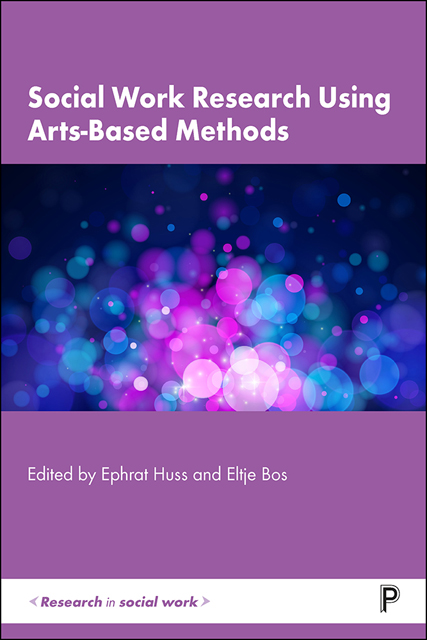Book contents
- Frontmatter
- Dedication
- Contents
- List of figures and tables
- Notes on contributors
- Introduction
- Section I Arts-based research as a method to understand and give voice to marginalised groups
- Section II Using arts-based research to listen to, and give voice to, children in social work
- Section III Arts-based research as a way for researchers and community members to understand communities
- Epilogue
- Index
Introduction
Published online by Cambridge University Press: 13 October 2022
- Frontmatter
- Dedication
- Contents
- List of figures and tables
- Notes on contributors
- Introduction
- Section I Arts-based research as a method to understand and give voice to marginalised groups
- Section II Using arts-based research to listen to, and give voice to, children in social work
- Section III Arts-based research as a way for researchers and community members to understand communities
- Epilogue
- Index
Summary
The connection between arts and social work is a rapidly developing area. However, the specific advantages of arts-based research for social work have yet to be articulated.
In research in general, arts are defined as less important than words, or numbers – a leitmotif, or illustration (Martinez-Brawley et al., 1997). Often ‘art’ is experienced as the opposite of ‘science’ and thus the opposite of ‘evidence’. In social work specifically, arts are experienced as a luxury, an illustration rather than content, peripheral rather than the ‘on the ground’ problems that social work deals with. Often social workers feel that they have not been trained in the arts and so cannot use it. This is based on a misunderstanding of what social art is. Indeed, arts-based research is most traditionally connected to education, where the use of images is a natural language for children (Eisner, 1997).
Of late, however, we see a ‘visual turn’ in social sciences in general, and also in social work practice and research. This includes the use of community art, Photovoice, outsider art, arts for social change, arts and health, arts to humanise institutions, de-stigmatise minorities, and to give voice to silenced groups (Chamberlayne & Smith, 2008; Huss, 2012, Huss & Bos, 2019). This has extended the use of arts-based research in social work.
This book aims to capture this promising process. It will show how artsbased research is in fact an especially effective methodology to embody, and will articulate many of the epistemological aims of, social work research. It will attempt to help break down the challenges for social workers when using arts-based methods through multiple methods and examples.
The aim of this introduction is to provide a conceptual rationale for using arts-based research in social work, as a theoretical lens through which to approach the chapters in this book, that then expand on this connection. This introduction also hopes to provide a general understanding of social arts that will help to demystify what is meant by arts in arts-based research. (Walton, 2012). This is an outline of the basic concepts of arts-based research, such as social art and art placement in research, that are illustrated in much more detail in the following chapters in this book.
- Type
- Chapter
- Information
- Social Work Research Using Arts-Based Methods , pp. 1 - 10Publisher: Bristol University PressPrint publication year: 2022

